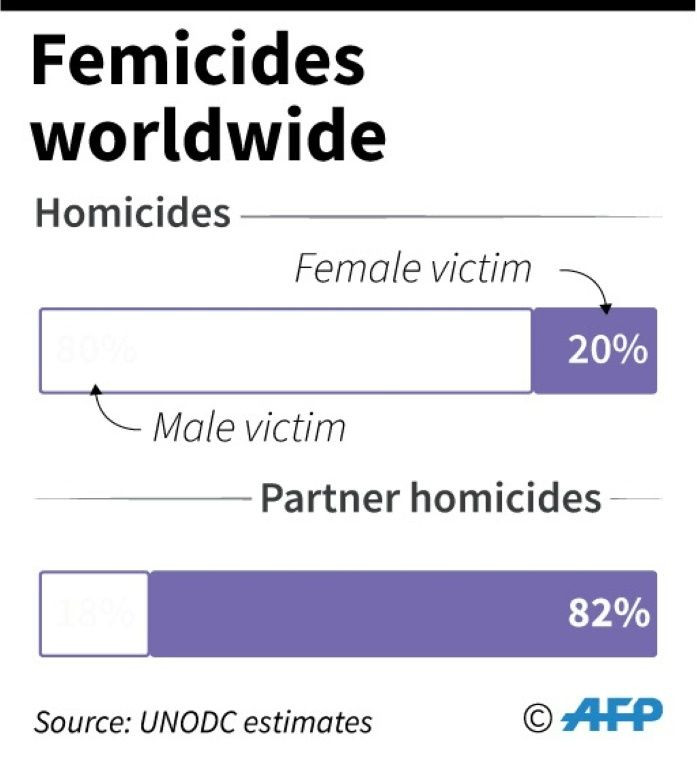Femicide: A Global Scourge

Every day in 2017, 137 women and girls were intentionally killed by their partner or a family member somewhere in the world, according to UN statistics.
This adds up to over 50,000 women's lives ended by those closest to them, a scourge blamed on deep-rooted gender inequality and damaging stereotypes of women as weaker and less valuable members of society.
Here is an overview of the worldwide killings of women, also called femicide.
In 2017, some 87,000 women and girls were murdered worldwide, according to a 2018 report of the UN Office on Drugs and Crime (UNODC).
Of these, 58 percent had their life taken by someone in their inner circle -- 30,000 by their spouse or intimate partner, and another 20,000 by a member of their own family.
The report showed that men were four times more likely than women to fall victim to homicide (they form 80 percent of all murder victims) but more often than not died at the hands of a stranger.
Fewer than one in five murdered men were killed by their life partner, compared to 82 percent for women.
Women in Africa are most likely to be killed by a spouse or family member, with a rate of nearly 70 percent (19,000 murders) compared to 38 percent (3,000 murders) in Europe, the region with the smallest share, said the UNODC.
In absolute numbers, Asia had the most severe toll, with 20,000 women killed by a partner or family member in 2017.
The high murder rate among women is a consequence of rampant gender-based violence.
Nearly a third of women who have been in a relationship reported having experienced physical or sexual violence at the hands of their partner, or a non-partner, according to a report by the World Health Organization (WHO).
"Many of the victims of 'femicide' are killed by their current and former partners, but they are also killed by fathers, brothers, mothers, sisters and other family members because of their role and status as women," said the UNODC.
These killings, it added, do "not usually result from random or spontaneous acts, but rather from the culmination of prior gender-based violence. Jealousy and fear of abandonment are among the motives."
The WHO report also blamed "unequal power of women relative to men" and the "normative use of violence to resolve conflict".
Emergencies such as poverty, war and humanitarian crises make women even more vulnerable.
Countries topping a UN-compiled list of "intentional homicides, female" are mostly in Latin America and Africa, regions which struggle with gang and ethnic wars, unemployment and privation.
Topping the list is El Salvador with 13.9 out of every 100,000 women murdered in 2017, followed by Jamaica with 11 per 100,000 in the same year.
The Central African Republic was in third place with 10.4 per 100,000 based on 2016 statistics, followed by South Africa with 9.1 per 100,000 in 2011.
The real numbers are likely to be higher, with reports based on whatever data is gathered by national statistical systems -- severely lacking in many countries in Africa and Asia.
Many wars, from the Democratic Republic of Congo and Burundi to Kosovo and Iraq, are known for the tactic of targeting women, who are raped, beaten, taken as sex slaves, and often killed, as a "weapon of war".
According to the UN, some 1,000 of the 5,000 so-called "honour killings" reported around the world every year, are committed in India.
These are crimes committed by close relatives after a woman or girl is deemed to have diverted from religious or traditional mores and values -- often for falling in love with a man from the wrong family, or for engaging in sex before marriage.
They are shot, stoned, burned, buried alive, strangled, smothered, or stabbed to death with what the UN describes as "horrifying regularity", often in countries where the laws exempt the perpetrators from punishment.
Pakistan sees hundreds of these killings every year, while in Afghanistan 243 cases were recorded between April 2011 and August 2013.
Spain is hailed in some quarters for turning the tide in the battle against femicide through a 2004 law against gender-targeted violence that sought to address the problem in different spheres simultaneously -- social, educational and correctional.
About 100 special courts and police units were also set up.
Last year, 50 women were murdered in Spain, and 51 so far this year, down from 71 in 2003.
Activists say the number is still too high in a country where judges are accused of bungling cases involving violence against women.
Last month, a court caused widespread anger by convicting five men accused of gang-raping a teenager of a lesser charge of sexual abuse on the grounds that she did not fight back.
There are action plans to combat violence against women in all of Canada's 10 provinces and marital violence has fallen since 2009.
"Training police has been one of the most beneficial factors," said Manon Monastesse, of the federation of homes of refuge for women.
But a woman still dies in Canada every six days at the hands of her partner, with indigenous Canadians six times more at risk.
© Copyright AFP 2024. All rights reserved.




















